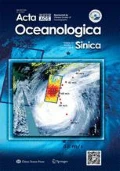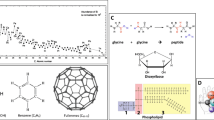Abstract
A method of measuring the tritium in seawater based on electrolytic enrichment and ultra-low background liquid scintillation counting techniques was established. The different factors influencing the detection limit were studied, including the counting time, the electrolytic volume of the seawater samples, the selection of background water, scintillation solution and their ratio. After optimizing the parameters and electrolyzing 350 mL volume of samples, the detection limit of the method was as low as 0.10 Bq/L. In order to test the optimization of system for this method, of the 84 seawater samples collected from the Arctic Ocean we measured, 92% were above the detection limit (the activity of this samples ranged from 0.10 Bq/L to 1.44 Bq/L with an average of (0.30±0.24) Bq/L). In future research, if we need to accurately measure the tritium activity in samples, the volume of the electrolytic samples will be increased to further reduce the minimum detectable activity.
Similar content being viewed by others
References
Aagaard K, Carmack E C. 1989. The role of sea ice and other fresh water in the Arctic circulation. Journal of Geophysical Research, 94(C10): 14485–14498, doi: https://doi.org/10.1029/JC094iC10p14485
Jacobs D G. 1968. Sources of tritium and its behavior upon release to the environment. United States: AEC Critial Review Series
Carmack E C. 2000. The Arctic Ocean’s freshwater budget: Sources, storage and export. In: Lewis E L, Jones E P, Lemke P, et al., eds. The Freshwater Budget of the Arctic Ocean. Dordrecht: Springer, 91–126
Carsten A L. 1979. Tritium in the environment. Advances in Radiation Biology, 8: 419–458, doi: https://doi.org/10.1016/B978-0-12-035408-5.50014-9
Cooper L W, McClelland J W, Holmes R M, et al. 2008. Flow-weighted values of runoff tracers (δ18O, DOC, Ba, alkalinity) from the six largest Arctic rivers. Geophysical Research Letters, 35(18): L18606, doi: https://doi.org/10.1029/2008GL035007
Dorsey H G, Peterson W H. 1976. Tritium in the Arctic Ocean and East Greenland current. Earth and Planetary Science Letters, 32(2): 342–350, doi: https://doi.org/10.1016/0012-821X(76)90074-1
Fourré E, Jean-Baptiste P, Dapoigny A, et al. 2006. Past and recent tritium levels in Arctic and Antarctic polar caps. Earth and Planetary Science Letters, 245(1–2): 56–64, doi: https://doi.org/10.1016/j.epsl.2006.03.003
Gröning M, Rozanski K. 2003. Uncertainty assessment of environmental tritium measurements in water. Accreditation and Quality Assurance, 8(7): 359–366
Hua Wei, Wen Wanxing. 2008. Summarization of the methods of monitoring environmental tritium. Chinese Journal of Radiological Health (in Chinese), 17(2): 250–251
Jakonić I, Todorovic N, Nikolov J, et al. 2014. Optimization of low-level LS counter Quantulus 1220 for tritium determination in water samples. Radiation Physics and Chemistry, 98: 69–76, doi: https://doi.org/10.1016/j.radphyschem.2014.01.012
Janovics R, Bihari Á, Papp L, et al. 2014. Monitoring of tritium, 60Co and 137Cs in the vicinity of the warm water outlet of the Paks Nuclear Power Plant, Hungary. Journal of Environmental Radioactivity, 128: 20–26, doi: https://doi.org/10.1016/j.jenvrad.2013.10.023
Kern Z, Molnár M, Svingor É, et al. 2009. High-resolution, well-preserved tritium record in the ice of Bortig Ice Cave, Bihor Mountains, Romania. The Holocene, 19(5): 729–736, doi: https://doi.org/10.1177/0959683609105296
Koarashi J, Mikami S, Nakada A, et al. 2008. Monitoring methodologies and chronology of radioactive airborne releases from Tokai reprocessing plant. Journal of Nuclear Science and Technology, 45(S5): 462–465
Nikolov J, Todorovic N, Jankovic M, et al. 2013. Different methods for tritium determination in surface water by LSC. Applied Radiation and Isotopes, 71(1): 51–56, doi: https://doi.org/10.1016/j.apradiso.2012.09.015
Peterson B J, Holmes R M, McClelland J W, et al. 2002. Increasing river discharge to the Arctic Ocean. Science, 298(5601): 2171–2173, doi: https://doi.org/10.1126/science.1077445
Popoaca S, Bucur C, Simionov V. 2014. Determination of 3H and 14C in organic sample after separation through combustion method. Journal of Energy and Power Engineering, 8: 1687–1694
Pujol L, Sanchez-Cabeza J A. 1999. Optimisation of liquid scintillation counting conditions for rapid tritium determination in aqueous samples. Journal of Radioanalytical and Nuclear Chemistry, 242(2): 391–398, doi: https://doi.org/10.1007/BF02345568
Serreze M C, Barrett A P, Slater A G, et al. 2006. The large-scale freshwater cycle of the Arctic. Journal of Geophysical Research, 111(C1): C11010
Thomson J. 2002. Quench and quench curves. In: Möbius S, Noakes J E, Schönhofer F, eds. Advances in Liquid Scintillation Spectrometry. Tucson: the University of Arizona Press, 65–73
Varlam C, Stefanescu I, Duliu O G, et al. 2009. Applying direct liquid scintillation counting to low level tritium measurement. Applied Radiation and Isotopes, 67(5): 812–816, doi: https://doi.org/10.1016/j.apradiso.2009.01.023
Wang Hua, Yin Jianjun, Yang Hui, et al. 2011. Application of the solid polymer electrolysis enrichment method for low level tritium in environmental water and the calculation of tritium specific activity. Rock and Mineral Analysis (in Chinese), 30(6): 745–750
Yi Y, Gibson J J, Cooper L W, et al. 2012. Isotopic signals (18O, 2H, 3H) of six major rivers draining the pan-Arctic watershe. Global Biogeochemical Cycles, 26(1): GB1027
Zhang Xiangyang, Liu Fuliang, Zhang Lin, et al. 2010. Quenching effect of tritium radioactivity in water samples analysis by liquid scintillation counting method. Rock and Mineral Analysis (in Chinese), 29(4): 469–471
Author information
Authors and Affiliations
Corresponding author
Additional information
Foundation item
The project sponsored by the Scientific Research Foundation of Third Institute of Oceanography, Ministry of Natural Resources, under contract No. 2020012; the Join Project of Xiamen Marine Research and Development Institute under contract No. K191301.
Acknowledgments
We thank the crew of R/V Xuelong for their help during sampling. We also thank LetPub (http://www.letpub.com) for its linguistic assistance during the preparation of this manuscript.
Rights and permissions
About this article
Cite this article
Lin, F., Yu, T., Yu, W. et al. Electrolytic enrichment method for tritium determination in the Arctic Ocean using liquid scintillation counter. Acta Oceanol. Sin. 39, 73–77 (2020). https://doi.org/10.1007/s13131-020-1647-4
Received:
Accepted:
Published:
Issue Date:
DOI: https://doi.org/10.1007/s13131-020-1647-4




